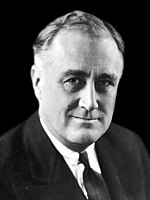| |||||||||||||||||||||||||||||
531 members of the Electoral College 266 electoral votes needed to win | |||||||||||||||||||||||||||||
|---|---|---|---|---|---|---|---|---|---|---|---|---|---|---|---|---|---|---|---|---|---|---|---|---|---|---|---|---|---|
| Turnout | 61.0%[1] | ||||||||||||||||||||||||||||
| |||||||||||||||||||||||||||||
 Presidential election results map. Blue denotes states won by Roosevelt/Garner, red denotes those won by Landon/Knox. Numbers indicate the number of electoral votes allotted to each state. | |||||||||||||||||||||||||||||
| |||||||||||||||||||||||||||||
The 1936 United States presidential election was the 38th quadrennial presidential election, held on Tuesday, November 3, 1936. In the midst of the Great Depression, incumbent Democratic President Franklin D. Roosevelt defeated Republican governor Alf Landon of Kansas in a landslide victory. Roosevelt won the highest share of the popular vote (60.8%) and the electoral vote (98.49%, carrying every state except Maine and Vermont) since the largely uncontested 1820 election. The sweeping victory consolidated the New Deal Coalition in control of the Fifth Party System.[2]
Roosevelt and Vice President John Nance Garner were renominated without opposition. With the backing of party leaders, Landon defeated progressive Senator William Borah at the 1936 Republican National Convention to win his party's presidential nomination. The populist Union Party nominated Congressman William Lemke for president.
The election took place as the Great Depression entered its eighth year. Roosevelt was still working to push the provisions of his New Deal economic policy through Congress and the courts. However, the New Deal policies he had already enacted, such as Social Security and unemployment benefits, had proven to be highly popular with most Americans. Landon, a political moderate, accepted much of the New Deal but criticized it for waste and inefficiency.
Roosevelt went on to win the greatest electoral landslide since the rise of hegemonic control between the Democratic and Republican parties in the 1850s. Roosevelt took 60.8% of the popular vote, while Landon won 36.56% and Lemke won 1.96%. Roosevelt carried every state except Maine and Vermont, which together cast eight electoral votes. By winning 523 electoral votes and 98.49% of the electoral vote total, this was the largest share of the Electoral College since 1820 and the second-largest number of raw electoral votes ever received by a candidate, and the largest ever for a Democrat. Roosevelt also won by the widest margin in the popular vote for a Democrat in history, although Lyndon Johnson would later win a slightly higher share of the popular vote in 1964, with 61.1%. Roosevelt's 523 electoral votes marked the first of only three times in American history when a presidential candidate received over 500 electoral votes in a presidential election (the others being in 1972 and 1984) and made Roosevelt the only Democratic president to accomplish this feat.
- ^ "Voter Turnout in Presidential Elections". The American Presidency Project. UC Santa Barbara.
- ^ Paul Kleppner et al. The Evolution of American Electoral Systems pp 219–225.

